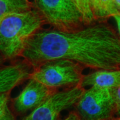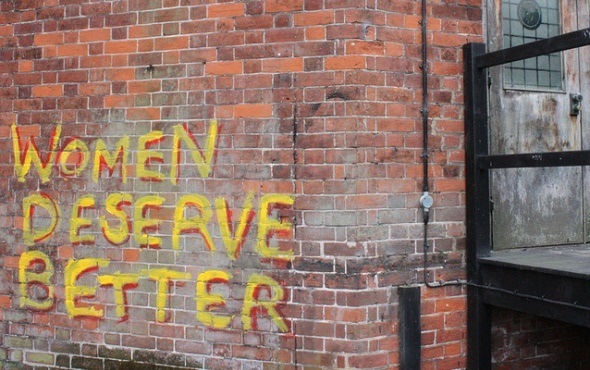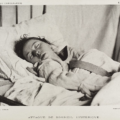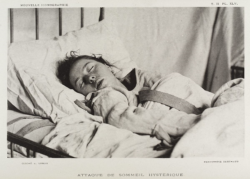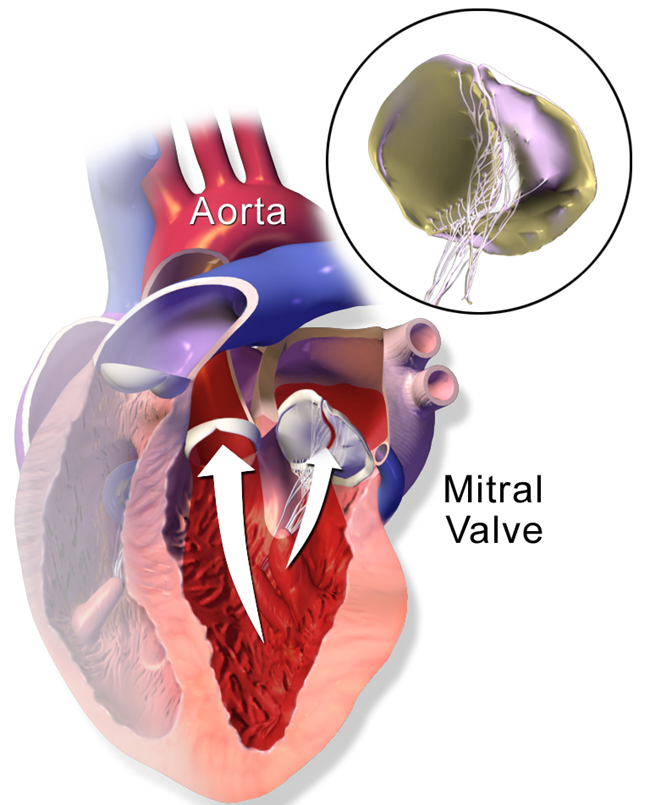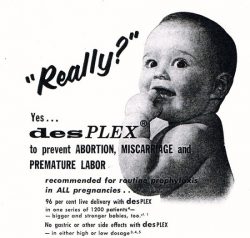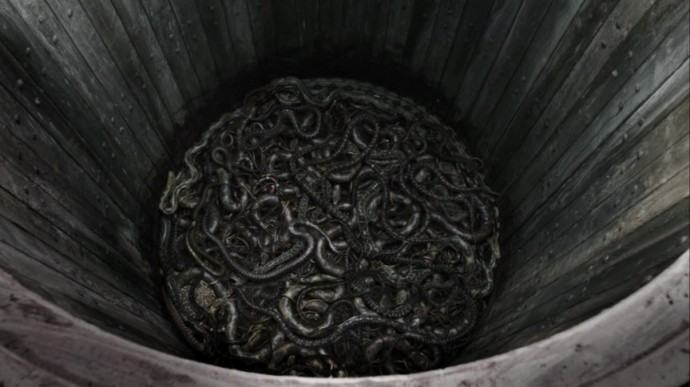Awareness ribbons looped on lapels. Around trees. Through chain-link fences. Yellow for missing children and bone cancer. Red for heart disease and HIV/AIDS. Blue for chronic fatigue syndrome and arthritis. Even ribbons spotted like Holstein cows raise awareness of birth defects.
The best known ribbons of all; pink for breast cancer.
Tangles of ribbons reminding us of human miseries we’d rather forget. Or have never heard of. But there are no satin ribbons for poor women who die young.
Even as their numbers climb.
Tie a Yellow Ribbon
Yellow ribbons first encircled trees in 1979, signifying hope for American hostages held in Iran. Red ribbons followed in 1992, to proclaim support for people with HIV/AIDS and encourage effort at finding a cure for the disease.
Pink ribbons fluttered on the scene in 1991. The earliest Komen Race for the Cure was held in Dallas, Texas in 1983. Participants in 1991’s Race in New York City were the first to receive the now-familiar pink ribbons.
Marshall McLuhan said “The medium is the message” more than 50 years ago, explaining:
The medium is the message because it is the medium that shapes and controls the scale and form of human association and action.
McLuhan didn’t have awareness ribbons in mind. He died in 1980. Though bright snippets and swathes of ribbon are a medium by McLuhan’s description. The ribbons convey messages that trigger emotional responses and actions.
But what messages are those ribbons sending? Especially the pink ones?
Dying Young
Most Americans expect to die old. We figure our lives will be longer than our grandparents. That our children will enjoy a few years more than we’ll have. Those are reasonable expectations. For most of us.
Not for poor white women. Their lives are shortening, not lengthening, according to a study published in Health Affairs in 2013. Researchers David Kindig and Erika Cheng compared female mortality across US counties. (The paper is available free here.)
They found life expectancy for some women has been dropping for decades. White women between ages 15 and 54 died younger than before in close to half of counties nationwide during the period from 1992 to 2006. The life expectancy for white men declined in just three percent of counties during the same time.
Other research (here, here and here) using different time periods and statistical methods, reach brighter–or gloomier–conclusions. All agree on the underlying fact that poor white women with little education are dying younger than better educated, better off women of similar ages.
Few states escaped increased female deaths. Only the counties in New England, along with Arizona, maintained or increased life expectancy for all women. Some states did much worse. Women across Appalachia, Oklahoma, the Deep South and northern Montana lost the most time.
The culprits that conspire to shorten lives aren’t surprising:
- Smoking
- Obesity
- Narcotic overdoses
- Suicide
Smoking, drug use and overeating are symptoms of deeper ills. Poverty, with its allies, hopelessness, no jobs, scanty education, are the true thieves of women’s lives.
The Urban Institute published a study in March, “Death Rates for US Women Ages 15 to 54: Some Unexpected Trends”. The authors Nan Marie Astone, Steven Martin and Laudan Aron, updated the findings from the earlier works. They also suggested a broader, more disturbing interpretation of the rise in women’s mortality:
The recent spike in white women’s mortality may be analogous to the spike in black mortality that accompanied the rise of the crack epidemic in the late 1980s and early 1990s. If so, one might predict that this mortality epidemic will ebb in the same way that several causes of death associated with the crack epidemic subsequently ebbed. The appropriate public health responses to such spikes are targeted interventions for the affected groups. A more troubling possibility is that white women are experiencing a systematic reversal in the long-term trend of mortality decline. Under this more pessimistic scenario, the high, stagnant, or rising death rates we observe among adult women now may persist as these women age, causing a substantial lowering of overall life expectancy in the United States. And because death rates are an indicator of population health, such a reversal in the trend of mortality decline would necessarily reflect widespread deficits in population health.
Ignoring the Evidence: Mammogram Wars
The relentless breast cancer screening debate stormed while poor women were dying in America’s heartland. Few subjects in health care are as acrimonious, riddled by politics and immune to science as the value of mammography.
Women, scientists, doctors and policymakers feud about whether breast cancer screening with mammograms saves lives. The fight has persisted for a generation without clear answers. If mammograms unquestionably saved lives, we’d know by now. We don’t.
Worse, mammography comes with risks. Over-diagnosis with its unnecessary treatment. Frequent false positives accompanied by anxiety, emotional distress and uncertainty that gnaw at women for years.
Truisms are reassuring because, well, they’re true. None truer than “A picture is worth 1000 words.” Two vivid infographics show the miniscule benefit of mammograms. The first is available on the NPR website. Published December 17, 2014, “What Happens After You Get That Mammogram”, estimates benefits and harms for 10,000 women who have yearly mammograms for ten years. It figures that:
- 3568 women will have normal mammograms each year for ten years
- 6130 women will have at least one false positive and 940 will have a biopsy they didn’t need.
- 302 women diagnosed with breast cancer
Of the 10,000 women who have annual mammograms, 302 will be diagnosed with cancer. It sound like a positive outcome, right? Maybe not. Here’s the catch. Of those 302:
- 173 would have survived with or without screening.
- 57 will be over-diagnosed with a cancer that would never have become a problem.
- 62 women will die despite being screened because of aggressive tumors.
- Ten lives will be saved.
A 100,000 mammograms must be done to save ten lives!
The other infographic illustrates an article from the New England Journal of Medicine. The piece was written by two Swiss doctors, members of the Swiss Medical Board, recommending against routine mammography screening for women 50-69 years old.
“Abolishing Mammography Screening Programs? A View from the Swiss Medical Board” is free at NEJM. The graph with the review compares American women’s perceptions of mammography benefit to the actual effects. It supposes 1000 women screened every two years for ten years:
- Women assume with screening 881 women will live, 80 will die from breast cancer and 39 will die from other causes.
- In reality, 956-957 screened women will live, 4 will die from breast cancer, 39 or 40 will die from other causes.
But, the surprising numbers are:
- Women expected 801 women to be alive without screening, 160 to die from breast cancer and 39 to die from other causes.
- When, in fact, 956 women will live without screening, 5 will die from breast cancer and 39 will lose their lives to other causes.
These numbers are central to the never-ending mammogram wars because women believe two crucially erroneous things about mammograms:
- Many more women will die without mammography, 16%, when in reality, it is one half a percent (0.5%)
- There’s a large difference in death rates between screened and unscreened women. The difference is just one woman.
No Free Lunch
The dismal performance of mammography screening matters regardless of cost. A screening test with little benefit and recognized harms isn’t a bargain even if it’s free. But mammograms aren’t free. (The Affordable Care Act requires that preventive mammograms be “free”. They aren’t. You pay for them with increased premiums and higher deductibles on other care.)
The annual cost of mammography screening was calculated at $7.8 billion in 2010 by a group of researchers writing in the Annals of Internal Medicine (gated) last year. The group then estimated the total costs for several proposed mammography guidelines for women 40 to 85 years old. Screening every year starting at 40, every other year from age 40 or every other year from 50 to 74. They assumed 85% of women would be screened (probably a high estimate). The price ranged from $10.1 billion for the most frequent screens to $2.6 billion for the least aggressive guidelines.
That is base cost. It does not include the extra fare when false positives and over-diagnoses are added. Mammography over-diagnosis runs another $4 billion per year, according to a recent calculation in Health Affairs. The price is likely much higher because the authors of the study only included women 40 to 59 years old. Older women needed fewer biopsies to find one case of cancer, but women ages 60 to 74 still had false alarms.
Americans are spending roughly $11 billion to $12 billion each year for a test of uncertain value and unneeded follow-up.
So what? Remember the dying women?
Zero Sum Game
The federal government is frozen in place, unwilling or unable to give ground on spending money to save lives. Most state governments are tied in knots, especially the states with climbing female death rates.
Politically powerful women and men fight to head off any cuts to mammography programs. An anguished howl was heard after the US Preventive Services Task Force (USPSTF) updated its 2009 Draft Recommendations last month. The panel found harms of mammograms for women 40 to 49 may outweigh benefits and downgraded their recommendation to “C”, threatening the “free” mammograms.
Senator Barbara Mikulski (D) of Maryland made her displeasure known at once to Secretary Burwell at the Department of Health and Human Services. The senator warned the secretary that:
[S]hould the draft recommendation be finalized, I will actively and aggressively pursue all legislative options available to ensure that women aged 40 and older are able to continue receiving free annual mammograms.
Money spent to care for people is now a zero sum game. One group’s win is another group’s loss. Money devoted to “free mammograms” may be money lost for care to Appalachian women.
After 30 years of worldwide research, billions of dollars and reams of federal legislation, we still don’t know whether mammography saves lives in the end. We don’t know whether $12 billion spent on women in Appalachia, Oklahoma and the Deep South will save lives, either. It’s time to find out.
The Color Of Shadows
What color awareness ribbon for women who die young? No ribbon, but the shadow of ribbons. The shadow cast by every pink ribbon should be their awareness symbol. Komen supporters Race for the Cure in the sunlight. Poor women race for their lives in the shadows.
When breast cancer activists run in races, the shadows running alongside are those of women dying too young.
We Need Your Help
More people than ever are reading Hormones Matter, a testament to the need for independent voices in health and medicine. We are not funded and accept limited advertising. Unlike many health sites, we don’t force you to purchase a subscription. We believe health information should be open to all. If you read Hormones Matter, like it, please help support it. Contribute now.
Yes, I would like to support Hormones Matter.
Image created using Canva AI.
This article was first published on May 26, 2015.



